Dissertation: GSCM's Impact on Organizational Performance in Hong Kong
VerifiedAdded on 2023/06/14
|71
|18259
|463
Thesis and Dissertation
AI Summary
This dissertation investigates the impact of Green Supply Chain Management (GSCM) on organizational performance, focusing on the manufacturing industry in Hong Kong. Through a secondary data analysis of the past five years, the study explores the costs, benefits, challenges, and implementation strategies of GSCM. The research uses a qualitative thematic study to analyze the collected data, revealing a positive correlation between the implementation of GSCM and improved organizational performance, including increased customer popularity, revenues, profit, and overall business growth. The study also provides recommendations for a possible GSCM model to improve the performance of organizations. Desklib offers similar solved assignments and resources for students.
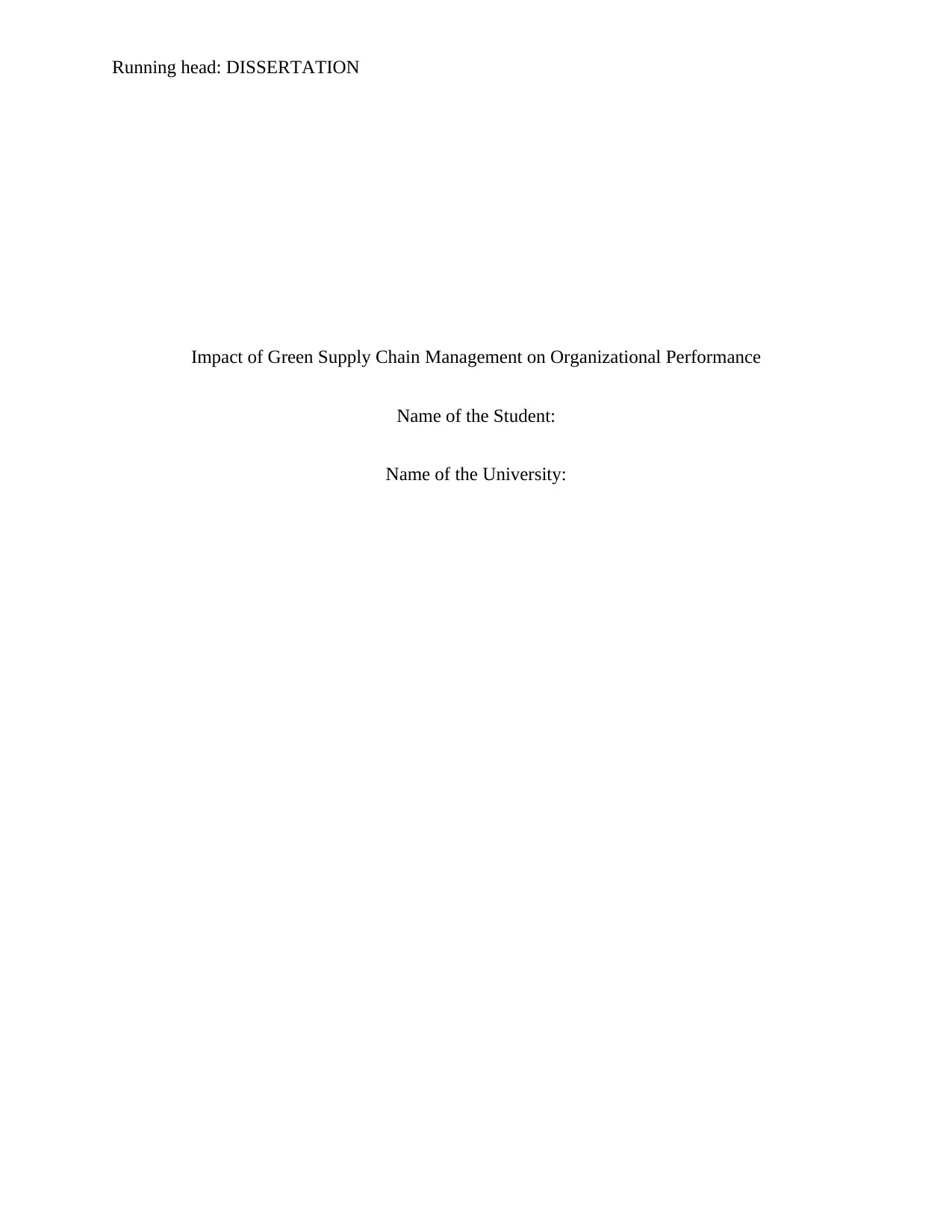
Running head: DISSERTATION
Impact of Green Supply Chain Management on Organizational Performance
Name of the Student:
Name of the University:
Impact of Green Supply Chain Management on Organizational Performance
Name of the Student:
Name of the University:
Paraphrase This Document
Need a fresh take? Get an instant paraphrase of this document with our AI Paraphraser
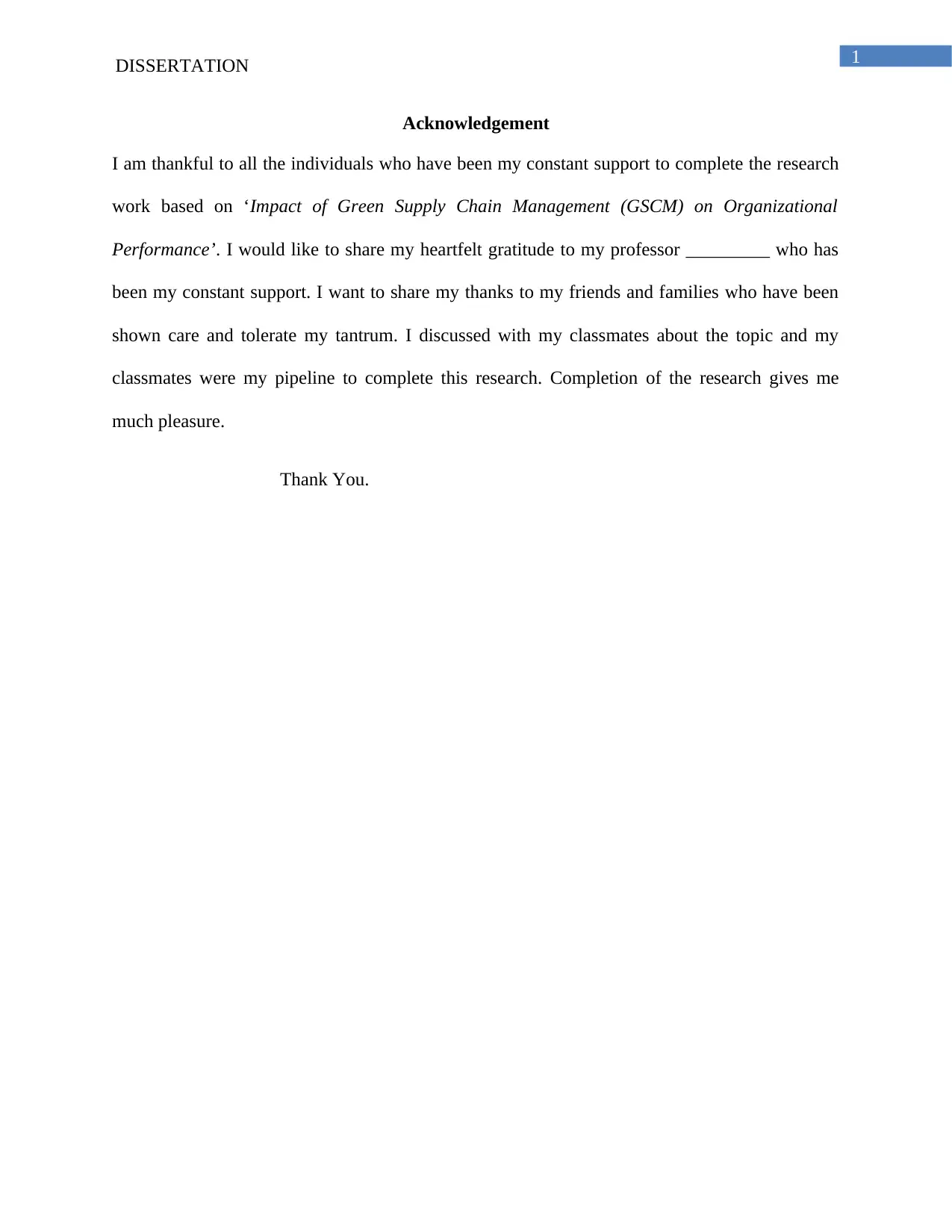
1DISSERTATION
Acknowledgement
I am thankful to all the individuals who have been my constant support to complete the research
work based on ‘Impact of Green Supply Chain Management (GSCM) on Organizational
Performance’. I would like to share my heartfelt gratitude to my professor _________ who has
been my constant support. I want to share my thanks to my friends and families who have been
shown care and tolerate my tantrum. I discussed with my classmates about the topic and my
classmates were my pipeline to complete this research. Completion of the research gives me
much pleasure.
Thank You.
Acknowledgement
I am thankful to all the individuals who have been my constant support to complete the research
work based on ‘Impact of Green Supply Chain Management (GSCM) on Organizational
Performance’. I would like to share my heartfelt gratitude to my professor _________ who has
been my constant support. I want to share my thanks to my friends and families who have been
shown care and tolerate my tantrum. I discussed with my classmates about the topic and my
classmates were my pipeline to complete this research. Completion of the research gives me
much pleasure.
Thank You.

2DISSERTATION
Abstract
Green Supply Chain Management (GSCM) is a trending practice of the modern industrial world.
As the environment is getting affected due to human activity, the implementation of GSCM has
become almost necessary to reduce the impact on the environment. The study revolves around
the impact of GSCM on the performances of the manufacturing industry of Hong Kong. The
researcher conducted a secondary data analysis on the implementation of GSCM in
manufacturing in Hong Kong. Information collected from the industry on the past five years and
through qualitative thematic study it has been found that with the growing application of green
supply chain has increased the popularity of the companies among the customers, which is
reflected in their revenues, profit and growth. It has been found that, the implementation of
GSCM has a positive impact on the organizational performance in the manufacturing industry of
Hong Kong.
Abstract
Green Supply Chain Management (GSCM) is a trending practice of the modern industrial world.
As the environment is getting affected due to human activity, the implementation of GSCM has
become almost necessary to reduce the impact on the environment. The study revolves around
the impact of GSCM on the performances of the manufacturing industry of Hong Kong. The
researcher conducted a secondary data analysis on the implementation of GSCM in
manufacturing in Hong Kong. Information collected from the industry on the past five years and
through qualitative thematic study it has been found that with the growing application of green
supply chain has increased the popularity of the companies among the customers, which is
reflected in their revenues, profit and growth. It has been found that, the implementation of
GSCM has a positive impact on the organizational performance in the manufacturing industry of
Hong Kong.
⊘ This is a preview!⊘
Do you want full access?
Subscribe today to unlock all pages.

Trusted by 1+ million students worldwide
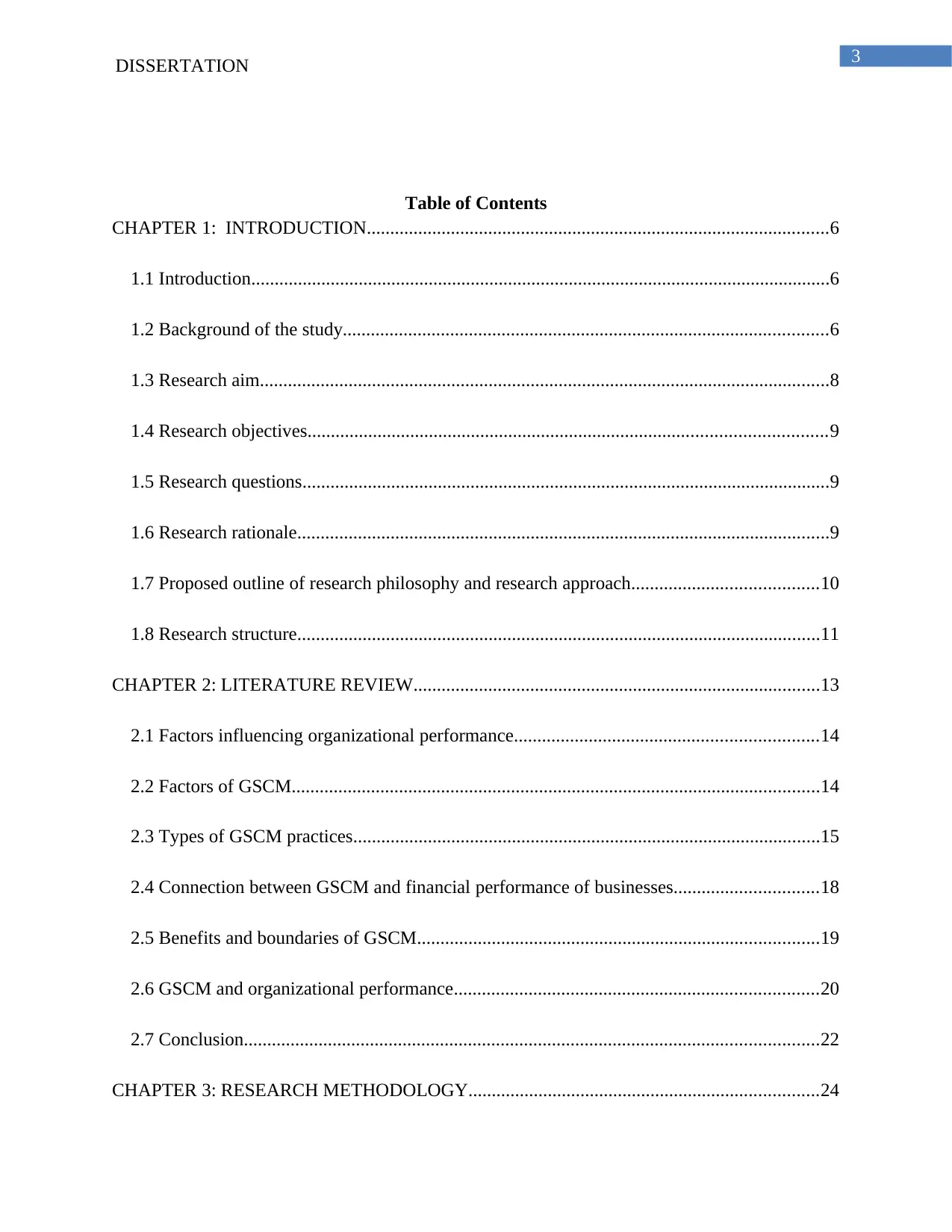
3DISSERTATION
Table of Contents
CHAPTER 1: INTRODUCTION...................................................................................................6
1.1 Introduction............................................................................................................................6
1.2 Background of the study........................................................................................................6
1.3 Research aim..........................................................................................................................8
1.4 Research objectives...............................................................................................................9
1.5 Research questions.................................................................................................................9
1.6 Research rationale..................................................................................................................9
1.7 Proposed outline of research philosophy and research approach........................................10
1.8 Research structure................................................................................................................11
CHAPTER 2: LITERATURE REVIEW.......................................................................................13
2.1 Factors influencing organizational performance.................................................................14
2.2 Factors of GSCM.................................................................................................................14
2.3 Types of GSCM practices....................................................................................................15
2.4 Connection between GSCM and financial performance of businesses...............................18
2.5 Benefits and boundaries of GSCM......................................................................................19
2.6 GSCM and organizational performance..............................................................................20
2.7 Conclusion...........................................................................................................................22
CHAPTER 3: RESEARCH METHODOLOGY...........................................................................24
Table of Contents
CHAPTER 1: INTRODUCTION...................................................................................................6
1.1 Introduction............................................................................................................................6
1.2 Background of the study........................................................................................................6
1.3 Research aim..........................................................................................................................8
1.4 Research objectives...............................................................................................................9
1.5 Research questions.................................................................................................................9
1.6 Research rationale..................................................................................................................9
1.7 Proposed outline of research philosophy and research approach........................................10
1.8 Research structure................................................................................................................11
CHAPTER 2: LITERATURE REVIEW.......................................................................................13
2.1 Factors influencing organizational performance.................................................................14
2.2 Factors of GSCM.................................................................................................................14
2.3 Types of GSCM practices....................................................................................................15
2.4 Connection between GSCM and financial performance of businesses...............................18
2.5 Benefits and boundaries of GSCM......................................................................................19
2.6 GSCM and organizational performance..............................................................................20
2.7 Conclusion...........................................................................................................................22
CHAPTER 3: RESEARCH METHODOLOGY...........................................................................24
Paraphrase This Document
Need a fresh take? Get an instant paraphrase of this document with our AI Paraphraser

4DISSERTATION
3.1 Research method outline......................................................................................................24
3.2 Research paradigm...............................................................................................................25
3.3 Research approach...............................................................................................................26
3.4 Research strategy.................................................................................................................26
3.5 Research design...................................................................................................................27
3.7 Data collection process and instruments..............................................................................28
3.5 Data analysis process...........................................................................................................29
3.6 Research timeline.................................................................................................................30
CHAPTER 4: DATA FINDINGS AND ANALYSIS...................................................................32
4.1 Introduction..........................................................................................................................32
4.2 Thematic analysis................................................................................................................32
4.3 Summary..............................................................................................................................49
CHAPTER 5: DISCUSSIONS......................................................................................................50
CHAPTER 6: RECOMMENDATIONS AND CONCLUSIONS.................................................55
6.1 Conclusions..........................................................................................................................55
6.2 Linking with objectives.......................................................................................................56
6.3 Recommendations................................................................................................................58
6.4 Future scope of the research................................................................................................61
Reference List................................................................................................................................62
Glossary.........................................................................................................................................69
3.1 Research method outline......................................................................................................24
3.2 Research paradigm...............................................................................................................25
3.3 Research approach...............................................................................................................26
3.4 Research strategy.................................................................................................................26
3.5 Research design...................................................................................................................27
3.7 Data collection process and instruments..............................................................................28
3.5 Data analysis process...........................................................................................................29
3.6 Research timeline.................................................................................................................30
CHAPTER 4: DATA FINDINGS AND ANALYSIS...................................................................32
4.1 Introduction..........................................................................................................................32
4.2 Thematic analysis................................................................................................................32
4.3 Summary..............................................................................................................................49
CHAPTER 5: DISCUSSIONS......................................................................................................50
CHAPTER 6: RECOMMENDATIONS AND CONCLUSIONS.................................................55
6.1 Conclusions..........................................................................................................................55
6.2 Linking with objectives.......................................................................................................56
6.3 Recommendations................................................................................................................58
6.4 Future scope of the research................................................................................................61
Reference List................................................................................................................................62
Glossary.........................................................................................................................................69

5DISSERTATION
⊘ This is a preview!⊘
Do you want full access?
Subscribe today to unlock all pages.

Trusted by 1+ million students worldwide
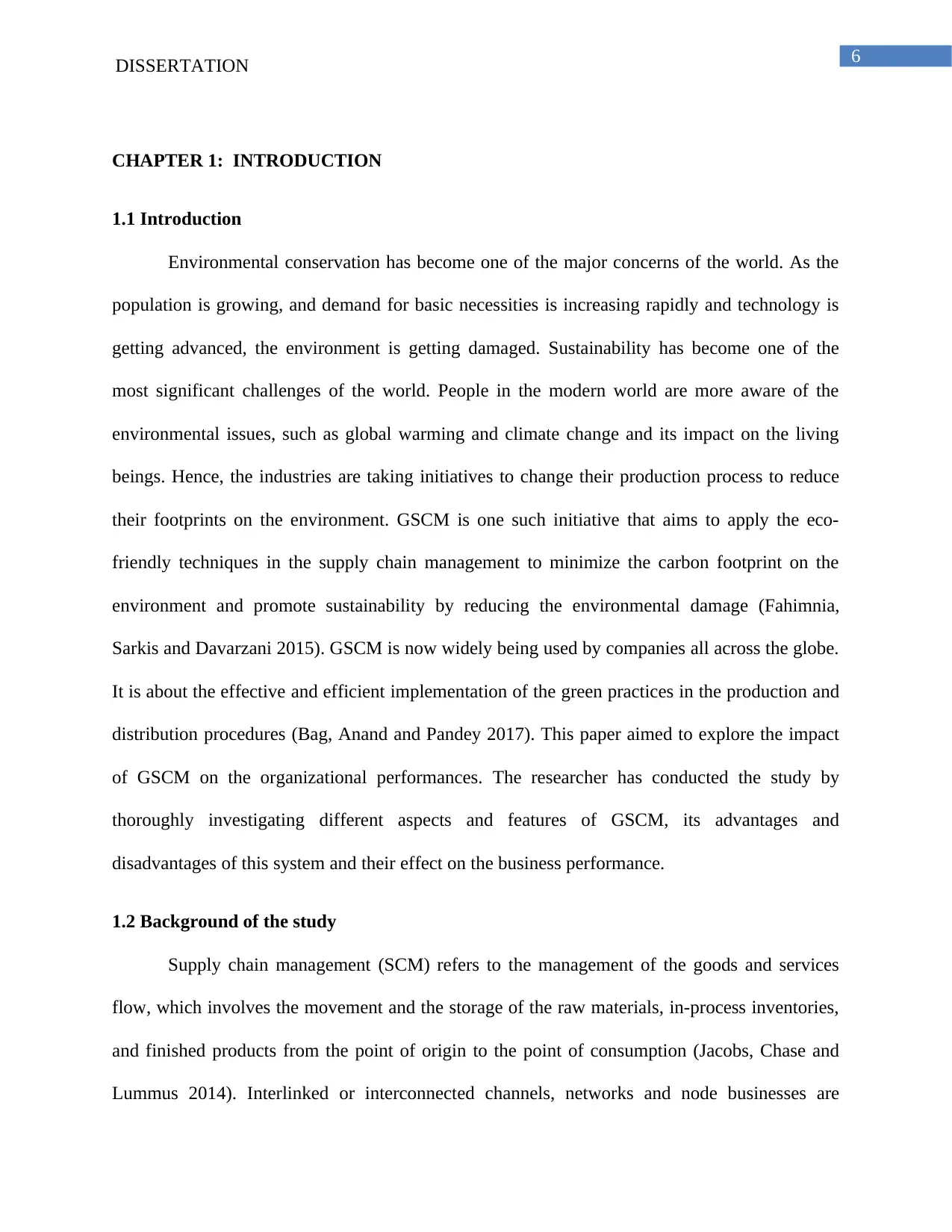
6DISSERTATION
CHAPTER 1: INTRODUCTION
1.1 Introduction
Environmental conservation has become one of the major concerns of the world. As the
population is growing, and demand for basic necessities is increasing rapidly and technology is
getting advanced, the environment is getting damaged. Sustainability has become one of the
most significant challenges of the world. People in the modern world are more aware of the
environmental issues, such as global warming and climate change and its impact on the living
beings. Hence, the industries are taking initiatives to change their production process to reduce
their footprints on the environment. GSCM is one such initiative that aims to apply the eco-
friendly techniques in the supply chain management to minimize the carbon footprint on the
environment and promote sustainability by reducing the environmental damage (Fahimnia,
Sarkis and Davarzani 2015). GSCM is now widely being used by companies all across the globe.
It is about the effective and efficient implementation of the green practices in the production and
distribution procedures (Bag, Anand and Pandey 2017). This paper aimed to explore the impact
of GSCM on the organizational performances. The researcher has conducted the study by
thoroughly investigating different aspects and features of GSCM, its advantages and
disadvantages of this system and their effect on the business performance.
1.2 Background of the study
Supply chain management (SCM) refers to the management of the goods and services
flow, which involves the movement and the storage of the raw materials, in-process inventories,
and finished products from the point of origin to the point of consumption (Jacobs, Chase and
Lummus 2014). Interlinked or interconnected channels, networks and node businesses are
CHAPTER 1: INTRODUCTION
1.1 Introduction
Environmental conservation has become one of the major concerns of the world. As the
population is growing, and demand for basic necessities is increasing rapidly and technology is
getting advanced, the environment is getting damaged. Sustainability has become one of the
most significant challenges of the world. People in the modern world are more aware of the
environmental issues, such as global warming and climate change and its impact on the living
beings. Hence, the industries are taking initiatives to change their production process to reduce
their footprints on the environment. GSCM is one such initiative that aims to apply the eco-
friendly techniques in the supply chain management to minimize the carbon footprint on the
environment and promote sustainability by reducing the environmental damage (Fahimnia,
Sarkis and Davarzani 2015). GSCM is now widely being used by companies all across the globe.
It is about the effective and efficient implementation of the green practices in the production and
distribution procedures (Bag, Anand and Pandey 2017). This paper aimed to explore the impact
of GSCM on the organizational performances. The researcher has conducted the study by
thoroughly investigating different aspects and features of GSCM, its advantages and
disadvantages of this system and their effect on the business performance.
1.2 Background of the study
Supply chain management (SCM) refers to the management of the goods and services
flow, which involves the movement and the storage of the raw materials, in-process inventories,
and finished products from the point of origin to the point of consumption (Jacobs, Chase and
Lummus 2014). Interlinked or interconnected channels, networks and node businesses are
Paraphrase This Document
Need a fresh take? Get an instant paraphrase of this document with our AI Paraphraser
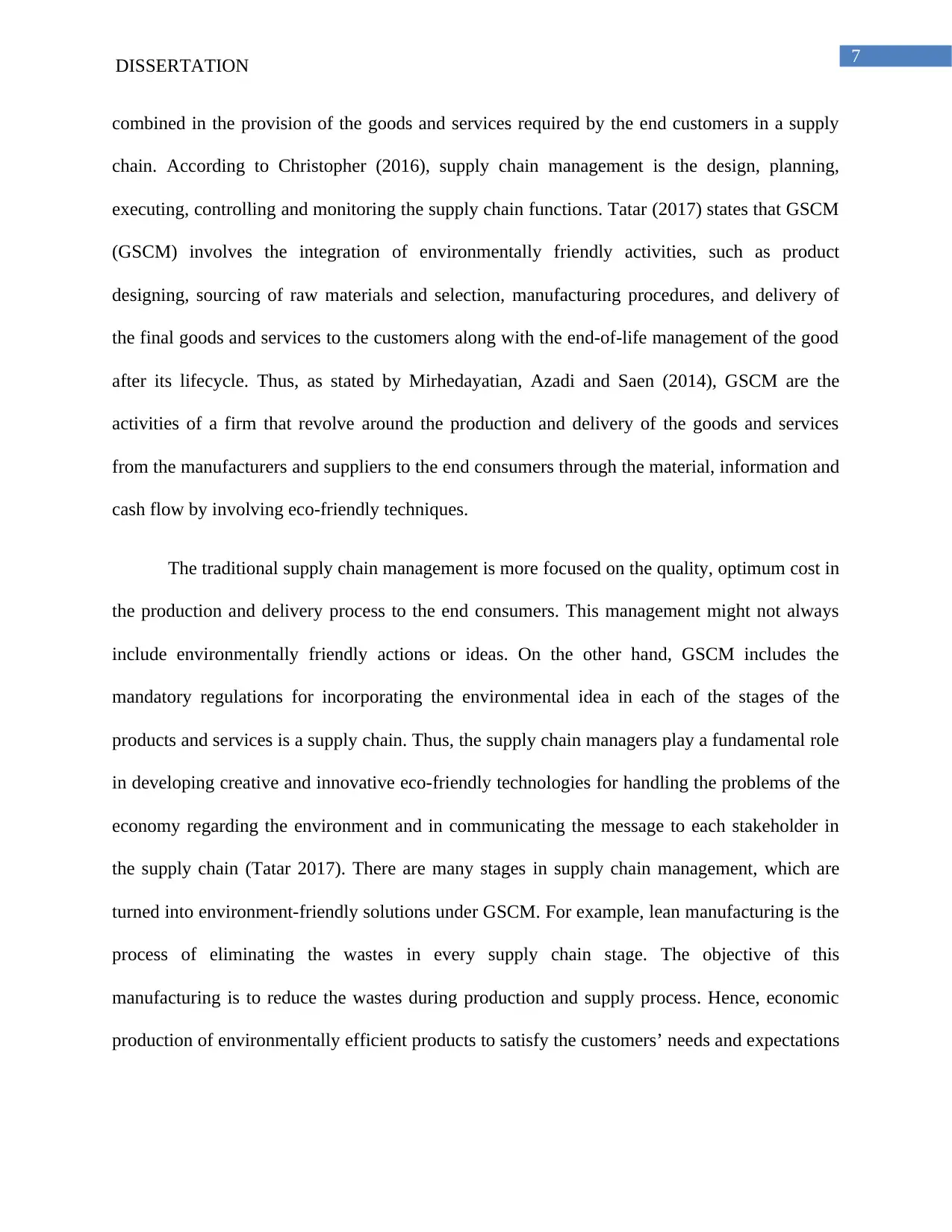
7DISSERTATION
combined in the provision of the goods and services required by the end customers in a supply
chain. According to Christopher (2016), supply chain management is the design, planning,
executing, controlling and monitoring the supply chain functions. Tatar (2017) states that GSCM
(GSCM) involves the integration of environmentally friendly activities, such as product
designing, sourcing of raw materials and selection, manufacturing procedures, and delivery of
the final goods and services to the customers along with the end-of-life management of the good
after its lifecycle. Thus, as stated by Mirhedayatian, Azadi and Saen (2014), GSCM are the
activities of a firm that revolve around the production and delivery of the goods and services
from the manufacturers and suppliers to the end consumers through the material, information and
cash flow by involving eco-friendly techniques.
The traditional supply chain management is more focused on the quality, optimum cost in
the production and delivery process to the end consumers. This management might not always
include environmentally friendly actions or ideas. On the other hand, GSCM includes the
mandatory regulations for incorporating the environmental idea in each of the stages of the
products and services is a supply chain. Thus, the supply chain managers play a fundamental role
in developing creative and innovative eco-friendly technologies for handling the problems of the
economy regarding the environment and in communicating the message to each stakeholder in
the supply chain (Tatar 2017). There are many stages in supply chain management, which are
turned into environment-friendly solutions under GSCM. For example, lean manufacturing is the
process of eliminating the wastes in every supply chain stage. The objective of this
manufacturing is to reduce the wastes during production and supply process. Hence, economic
production of environmentally efficient products to satisfy the customers’ needs and expectations
combined in the provision of the goods and services required by the end customers in a supply
chain. According to Christopher (2016), supply chain management is the design, planning,
executing, controlling and monitoring the supply chain functions. Tatar (2017) states that GSCM
(GSCM) involves the integration of environmentally friendly activities, such as product
designing, sourcing of raw materials and selection, manufacturing procedures, and delivery of
the final goods and services to the customers along with the end-of-life management of the good
after its lifecycle. Thus, as stated by Mirhedayatian, Azadi and Saen (2014), GSCM are the
activities of a firm that revolve around the production and delivery of the goods and services
from the manufacturers and suppliers to the end consumers through the material, information and
cash flow by involving eco-friendly techniques.
The traditional supply chain management is more focused on the quality, optimum cost in
the production and delivery process to the end consumers. This management might not always
include environmentally friendly actions or ideas. On the other hand, GSCM includes the
mandatory regulations for incorporating the environmental idea in each of the stages of the
products and services is a supply chain. Thus, the supply chain managers play a fundamental role
in developing creative and innovative eco-friendly technologies for handling the problems of the
economy regarding the environment and in communicating the message to each stakeholder in
the supply chain (Tatar 2017). There are many stages in supply chain management, which are
turned into environment-friendly solutions under GSCM. For example, lean manufacturing is the
process of eliminating the wastes in every supply chain stage. The objective of this
manufacturing is to reduce the wastes during production and supply process. Hence, economic
production of environmentally efficient products to satisfy the customers’ needs and expectations
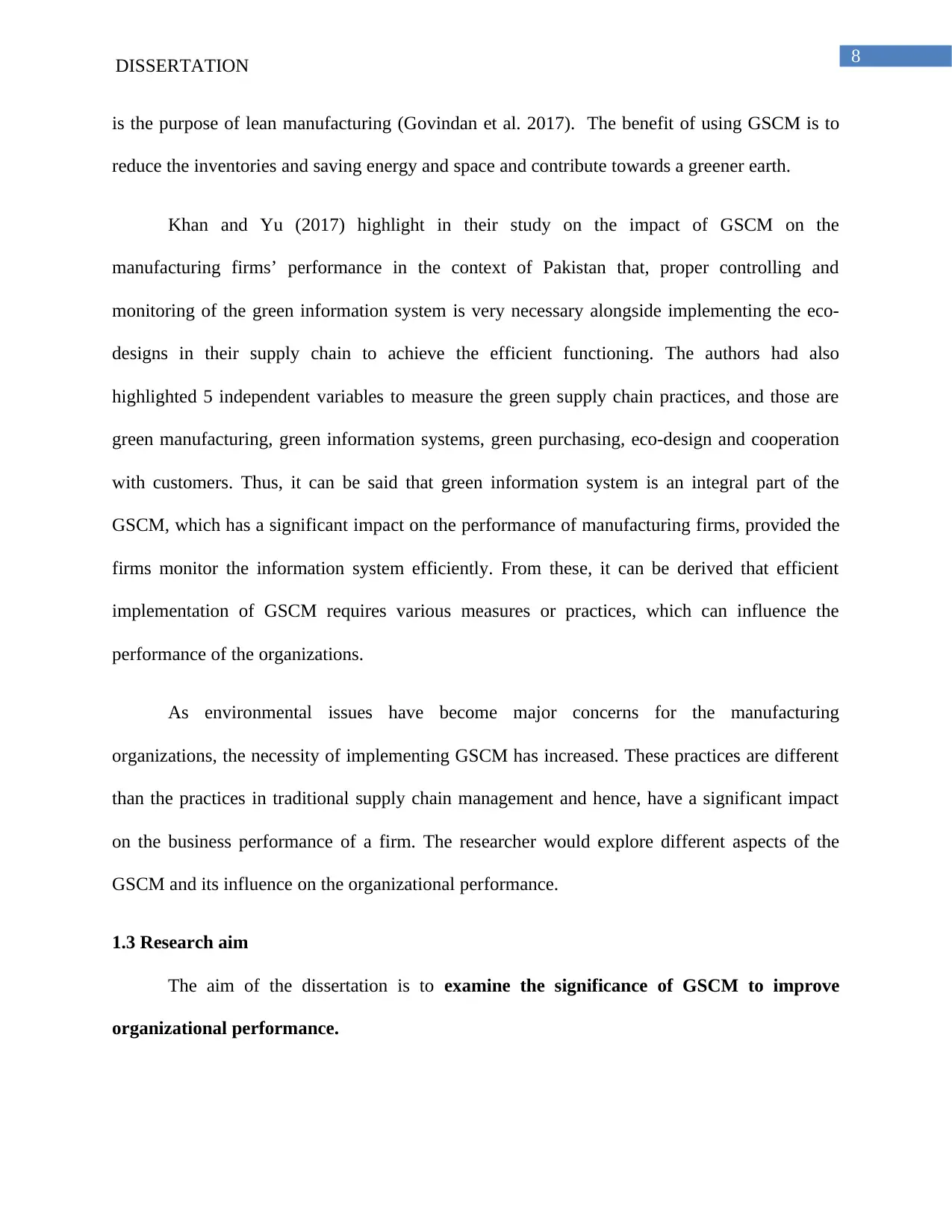
8DISSERTATION
is the purpose of lean manufacturing (Govindan et al. 2017). The benefit of using GSCM is to
reduce the inventories and saving energy and space and contribute towards a greener earth.
Khan and Yu (2017) highlight in their study on the impact of GSCM on the
manufacturing firms’ performance in the context of Pakistan that, proper controlling and
monitoring of the green information system is very necessary alongside implementing the eco-
designs in their supply chain to achieve the efficient functioning. The authors had also
highlighted 5 independent variables to measure the green supply chain practices, and those are
green manufacturing, green information systems, green purchasing, eco-design and cooperation
with customers. Thus, it can be said that green information system is an integral part of the
GSCM, which has a significant impact on the performance of manufacturing firms, provided the
firms monitor the information system efficiently. From these, it can be derived that efficient
implementation of GSCM requires various measures or practices, which can influence the
performance of the organizations.
As environmental issues have become major concerns for the manufacturing
organizations, the necessity of implementing GSCM has increased. These practices are different
than the practices in traditional supply chain management and hence, have a significant impact
on the business performance of a firm. The researcher would explore different aspects of the
GSCM and its influence on the organizational performance.
1.3 Research aim
The aim of the dissertation is to examine the significance of GSCM to improve
organizational performance.
is the purpose of lean manufacturing (Govindan et al. 2017). The benefit of using GSCM is to
reduce the inventories and saving energy and space and contribute towards a greener earth.
Khan and Yu (2017) highlight in their study on the impact of GSCM on the
manufacturing firms’ performance in the context of Pakistan that, proper controlling and
monitoring of the green information system is very necessary alongside implementing the eco-
designs in their supply chain to achieve the efficient functioning. The authors had also
highlighted 5 independent variables to measure the green supply chain practices, and those are
green manufacturing, green information systems, green purchasing, eco-design and cooperation
with customers. Thus, it can be said that green information system is an integral part of the
GSCM, which has a significant impact on the performance of manufacturing firms, provided the
firms monitor the information system efficiently. From these, it can be derived that efficient
implementation of GSCM requires various measures or practices, which can influence the
performance of the organizations.
As environmental issues have become major concerns for the manufacturing
organizations, the necessity of implementing GSCM has increased. These practices are different
than the practices in traditional supply chain management and hence, have a significant impact
on the business performance of a firm. The researcher would explore different aspects of the
GSCM and its influence on the organizational performance.
1.3 Research aim
The aim of the dissertation is to examine the significance of GSCM to improve
organizational performance.
⊘ This is a preview!⊘
Do you want full access?
Subscribe today to unlock all pages.

Trusted by 1+ million students worldwide

9DISSERTATION
1.4 Research objectives
The research objectives are:
To evaluate the costs and benefits of GSCM
To explore the strategies for implementing GSCM
To assess the potential challenges of implementing GSCM
To recommend a possible GSCM model to improve the performance of the organizations
1.5 Research questions
1) What are the advantages and disadvantages of GSCM?
2) What strategies are usually undertaken by the firms while implementing the GSCM?
3) What are the potential challenges that the firms face while applying the GSCM
techniques?
4) What is the impact of GSCM techniques on the business performance of the firms
implementing these techniques?
1.6 Research rationale
GSCM has become a trend in the industries across the world. As the industrial activities
are increasing rapidly, the environmental damages are increasing too. Hence, the implementation
of GSCM has become necessary for a sustainable future, as GSCM aims to reduce the wastes,
which includes harmful chemicals, solid and energy wastes, GHG emissions and to incorporate
environmental sustainability. On the other hand, the industries operate for making profits. Hence,
to increase productivity and profitability and reduce the cost of production, they often ignore the
environment-friendly practices, which incur the high cost. The organizations that use natural
1.4 Research objectives
The research objectives are:
To evaluate the costs and benefits of GSCM
To explore the strategies for implementing GSCM
To assess the potential challenges of implementing GSCM
To recommend a possible GSCM model to improve the performance of the organizations
1.5 Research questions
1) What are the advantages and disadvantages of GSCM?
2) What strategies are usually undertaken by the firms while implementing the GSCM?
3) What are the potential challenges that the firms face while applying the GSCM
techniques?
4) What is the impact of GSCM techniques on the business performance of the firms
implementing these techniques?
1.6 Research rationale
GSCM has become a trend in the industries across the world. As the industrial activities
are increasing rapidly, the environmental damages are increasing too. Hence, the implementation
of GSCM has become necessary for a sustainable future, as GSCM aims to reduce the wastes,
which includes harmful chemicals, solid and energy wastes, GHG emissions and to incorporate
environmental sustainability. On the other hand, the industries operate for making profits. Hence,
to increase productivity and profitability and reduce the cost of production, they often ignore the
environment-friendly practices, which incur the high cost. The organizations that use natural
Paraphrase This Document
Need a fresh take? Get an instant paraphrase of this document with our AI Paraphraser

10DISSERTATION
resources must manage the resources in the most efficient manner to maintain the long-term
sustainability and profitability (Brandenburg et al. 2014).
The awareness about the global warming and other environmental issues started from the
1990s and the firms started to incorporate the ethical CSR policies in their operations including
the supply chain (Luthra, Garg and Haleem 2015). The ethical and green practices adopted by
the firms help them to gain an advantage in the industry as consumers have become more aware
of the environmental sustainability. Hence, the integration of green practices in the
manufacturing and supply process of the firms has gained importance among the consumers as
they are now more concerned about those. Hence, organizations following GSCM are being able
to capture the market share and that share is increasing. Organizational performance depends on
many factors including the GSCM. The researcher explored the extent to which the
implementation of GSCM impacts the organizational performance. The advantages,
disadvantages and potential challenges of the implementation of the GSCM practices were
explored through this research study.
1.7 Proposed outline of research philosophy and research approach
The researcher has adopted the interpretivism research philosophy to address the research
questions. Since, the topic of the study aimed to explore the impact of GSCM practices on the
business performance in the manufacturing industry in Hong Kong; it would be most suitable to
analyze the impact of these practices using qualitative method. Collecting primary data would be
difficult and hence, the researcher would collect secondary data on the past 5 years from the
manufacturing industry of Hong Kong regarding the implementation of GSCM and its impact on
the business growth. Interpretivism allowed the researcher to use the interpretation skills to
investigate the information regarding the research topic and present the analysis in a thematic
resources must manage the resources in the most efficient manner to maintain the long-term
sustainability and profitability (Brandenburg et al. 2014).
The awareness about the global warming and other environmental issues started from the
1990s and the firms started to incorporate the ethical CSR policies in their operations including
the supply chain (Luthra, Garg and Haleem 2015). The ethical and green practices adopted by
the firms help them to gain an advantage in the industry as consumers have become more aware
of the environmental sustainability. Hence, the integration of green practices in the
manufacturing and supply process of the firms has gained importance among the consumers as
they are now more concerned about those. Hence, organizations following GSCM are being able
to capture the market share and that share is increasing. Organizational performance depends on
many factors including the GSCM. The researcher explored the extent to which the
implementation of GSCM impacts the organizational performance. The advantages,
disadvantages and potential challenges of the implementation of the GSCM practices were
explored through this research study.
1.7 Proposed outline of research philosophy and research approach
The researcher has adopted the interpretivism research philosophy to address the research
questions. Since, the topic of the study aimed to explore the impact of GSCM practices on the
business performance in the manufacturing industry in Hong Kong; it would be most suitable to
analyze the impact of these practices using qualitative method. Collecting primary data would be
difficult and hence, the researcher would collect secondary data on the past 5 years from the
manufacturing industry of Hong Kong regarding the implementation of GSCM and its impact on
the business growth. Interpretivism allowed the researcher to use the interpretation skills to
investigate the information regarding the research topic and present the analysis in a thematic
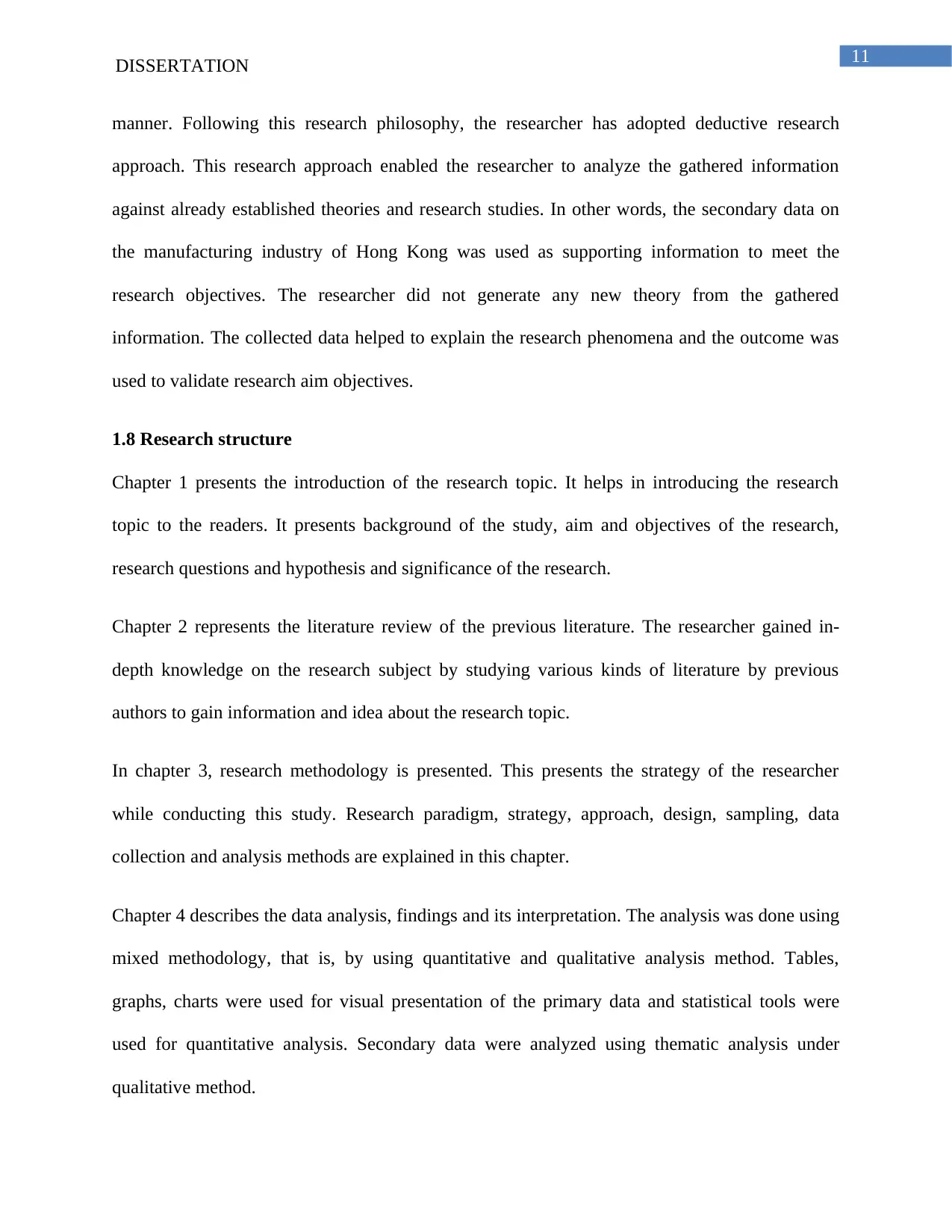
11DISSERTATION
manner. Following this research philosophy, the researcher has adopted deductive research
approach. This research approach enabled the researcher to analyze the gathered information
against already established theories and research studies. In other words, the secondary data on
the manufacturing industry of Hong Kong was used as supporting information to meet the
research objectives. The researcher did not generate any new theory from the gathered
information. The collected data helped to explain the research phenomena and the outcome was
used to validate research aim objectives.
1.8 Research structure
Chapter 1 presents the introduction of the research topic. It helps in introducing the research
topic to the readers. It presents background of the study, aim and objectives of the research,
research questions and hypothesis and significance of the research.
Chapter 2 represents the literature review of the previous literature. The researcher gained in-
depth knowledge on the research subject by studying various kinds of literature by previous
authors to gain information and idea about the research topic.
In chapter 3, research methodology is presented. This presents the strategy of the researcher
while conducting this study. Research paradigm, strategy, approach, design, sampling, data
collection and analysis methods are explained in this chapter.
Chapter 4 describes the data analysis, findings and its interpretation. The analysis was done using
mixed methodology, that is, by using quantitative and qualitative analysis method. Tables,
graphs, charts were used for visual presentation of the primary data and statistical tools were
used for quantitative analysis. Secondary data were analyzed using thematic analysis under
qualitative method.
manner. Following this research philosophy, the researcher has adopted deductive research
approach. This research approach enabled the researcher to analyze the gathered information
against already established theories and research studies. In other words, the secondary data on
the manufacturing industry of Hong Kong was used as supporting information to meet the
research objectives. The researcher did not generate any new theory from the gathered
information. The collected data helped to explain the research phenomena and the outcome was
used to validate research aim objectives.
1.8 Research structure
Chapter 1 presents the introduction of the research topic. It helps in introducing the research
topic to the readers. It presents background of the study, aim and objectives of the research,
research questions and hypothesis and significance of the research.
Chapter 2 represents the literature review of the previous literature. The researcher gained in-
depth knowledge on the research subject by studying various kinds of literature by previous
authors to gain information and idea about the research topic.
In chapter 3, research methodology is presented. This presents the strategy of the researcher
while conducting this study. Research paradigm, strategy, approach, design, sampling, data
collection and analysis methods are explained in this chapter.
Chapter 4 describes the data analysis, findings and its interpretation. The analysis was done using
mixed methodology, that is, by using quantitative and qualitative analysis method. Tables,
graphs, charts were used for visual presentation of the primary data and statistical tools were
used for quantitative analysis. Secondary data were analyzed using thematic analysis under
qualitative method.
⊘ This is a preview!⊘
Do you want full access?
Subscribe today to unlock all pages.

Trusted by 1+ million students worldwide
1 out of 71
Related Documents
Your All-in-One AI-Powered Toolkit for Academic Success.
+13062052269
info@desklib.com
Available 24*7 on WhatsApp / Email
![[object Object]](/_next/static/media/star-bottom.7253800d.svg)
Unlock your academic potential
Copyright © 2020–2026 A2Z Services. All Rights Reserved. Developed and managed by ZUCOL.





